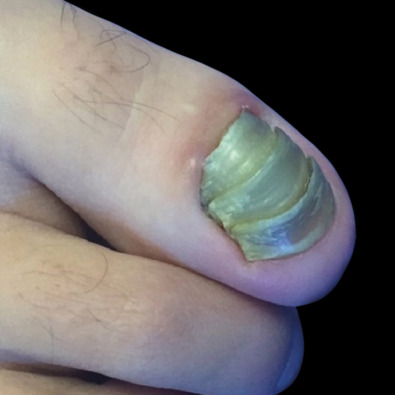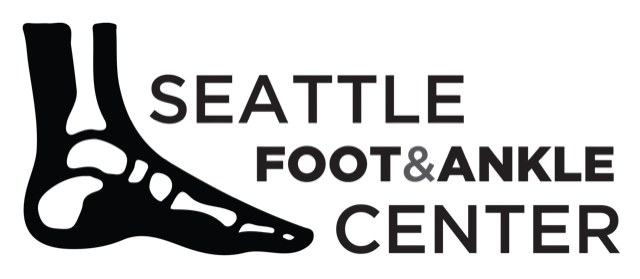Retronychia, a prevalent yet often overlooked condition, affects the growth of toenails, potentially leading to discomfort or infection if left unmanaged. This challenge emphasizes the importance of recognizing early symptoms.
Understanding retronychia is crucial for preventing complications.
By fostering awareness of causes and symptoms, individuals can take proactive steps toward maintaining optimal nail health and overall well-being.

What Is Retronychia?
Retronychia is a nail condition that occurs when the nail plate penetrates the proximal nail fold.
In 1999, Marco Rigoni, a noted Italian dermatologist, introduced this condition’s nuanced characteristics, drawing attention to an often misunderstood aspect of nail health. When it comes to retronychia, the backward growth of the nail into the cuticle can cause inflammation and pain.
Typically, it’s the body’s response to trauma or repeated pressure—a common experience for those who find themselves frequently engaged in activities requiring tight-fitting shoes or vigorous physical activity. This leads to the development of multiple layers of the nail plate trapped underneath the flesh, triggering swelling and redness.
Understanding the mechanics of this condition not only prevents imminent nail damage but also underscores the relevance of precise diagnosis and timely intervention. Affected individuals often display the presence of the distal nail edge rising, an example of the body’s natural protective measures, offering vital pointers for recognition.
In navigating retronychia, timely attention mitigates discomfort and successfully restores comfort and confidence.
Identifying Early Signs
Spotting the early signs of retronychia is essential for effective management and recovery. What should you look for?
In 2016, expert dermatologists identified a pattern of changes that signify the onset of retronychia. Watch for swelling and tenderness around the affected nail, as these can be crucial indicators.
Initially, it’s not uncommon for hairline cracks or white patches to emerge at the nail’s base. These subtle changes may appear before any noticeable pain, signaling the first step of nail plate backtracking.
Observe for a feeling of increased pressure beneath the nail, signaling it’s struggling to grow properly. This uncomfortable sensation, coupled with a diminished ability to fully bend the tip of the finger, may herald retronychia’s advance.
Regularly monitoring these signs can make a significant difference. Early detection enables timely intervention, restoring health and the confidence to engage in daily activities.
Common Causes of Retronychia
Retronychia emerges primarily due to an interruption in the nail’s growth cycle, causing the nail to start growing into the proximal nail fold.
This condition often stems from repeated trauma to the nail area, whether from sports activities, ill-fitting footwear, or habitual use of high-impact or intricate manual tasks. Such repetitive stress can injure the nail matrix, leading to this perplexing and uncomfortable growth issue.
Moreover, systemic factors such as endocrinological imbalances may play a role in predisposing individuals to retronychia. For instance, certain systemic diseases can affect nail matrix function, potentially leading to abnormal growth patterns.
Furthermore, a history of nail infections, such as paronychia, can exacerbate vulnerabilities in the nail structure, compounding the challenges in nail growth. With a strong focus on understanding these causes, healthcare providers like Dr. Hoy can design personalized strategies that prevent and manage retronychia more effectively, enlightening patients with hope and determination to restore their nail health.
Triggers and Risk Factors
Certain individual behaviors and environmental conditions can significantly elevate the likelihood of developing retronychia. Activities involving repeated pressure on the toenails, such as running, dancing, or wearing tight shoes, are known contributors to the cascade of this condition.
Medical conditions that compromise circulation or affect nail growth, alongside genetic predispositions, further amplify the susceptibility to retronychia. Awareness and proactive management of these factors can empower patients to pursue optimal nail health.
Impact of Trauma
Trauma to the toenail often acts as a catalyst in the development of retronychia, initiating a sequence of changes that disrupt normal nail growth. This trauma may include blunt force impacts.
Repeated mechanical stress can exacerbate the condition, particularly when pressure is consistently applied to the nail matrix. This not only alters the nail’s structural integrity but also inflames the surrounding tissues.
Continuous trauma can significantly impair normal toenail growth and elevate the risk of retronychia.
Effective management and timing in addressing these injuries can significantly alter the prognosis. By engaging in strategic interventions that promote healing and prevent further damage, individuals can safeguard both their nail health and overall well-being, inspiring resilience and regrowth in challenging conditions.
Influence of Nail Care Habits
Proper nail care habits can significantly influence your susceptibility to retronychia and other nail conditions, thus enhancing the resilience and health of your nails.
Optimal nail maintenance, which encompasses a deliberate approach toward trimming and grooming, plays a pivotal role. When nails are cut too short or improperly, the likelihood of retronychia increases, as these habits may facilitate an environment conducive to nail embedding and shifting. Moreover, unkempt nails are more prone to harboring pathogens, further emphasizing the importance of a well-rounded grooming routine.
Conversely, routine care such as keeping nails at a practical length can deter misalignments. As trimming ends at an appropriate length, it reinforces the structural robustness and aesthetic appeal of nails while aiding in the prevention of potentially detrimental conditions like retronychia.
Thus, incorporating thoughtful nail care regimens into your lifestyle not only reduces the prevalence of retronychia but also emboldens a journey toward healthier nail longevity. By elevating and adhering to advanced care practices, individuals can fortify their nails against adversity, showcasing an inspiring testament to the power of mindful grooming in achieving optimal well-being.
Symptoms of Retronychia
Initially, retronychia may manifest as redness, swelling, and tenderness around the affected nail area.
In the progressing stages, one might experience persistent pain in the proximal nail fold as the nail plate begins to embed backward, causing significant discomfort. These symptoms are often accompanied by the thickening of the soft tissue around the nail, resulting in a visible bulge that can escalate if the condition is untreated.
Consequently, there may be an onset of a yellowish discoloration of the nail surface. While inspecting these changes, individuals may also notice the emergence of pus, indicating a possible infection that further underscores the growing complexity of the condition.
Recognizing these symptoms of retronychia empowers individuals to seek timely intervention, potentially mitigating more severe outcomes, such as permanent nail damage. Left unchecked, retronychia might compromise nail integrity, leading to a cyclic pattern of pain and infection. Awareness and early detection remain pivotal, as these proactive measures fortify one’s commitment to overcoming nail challenges and underscore the transformative power of informed healthcare choices.
Recognizing Nail Changes
Vigilance is key when identifying retronychia signs.
Understanding retronychia starts with the nail’s appearance. The first indicator to watch for might be the subtle thickening of the proximal nail fold, coupled with an unusual tenderness around the area. Additionally, there can be a conspicuous alteration in the nail’s natural coloration, signaling an underlying issue.
Other symptoms could include pain and swelling.
These nail transformations serve as early alarms – in the same way a smoke detector warns of a fire – and highlight the necessity for prompt medical attention and tailored treatments.
With increased awareness, individuals can recognize retronychia’s early manifestations and seek experienced guidance, solidifying their resolve to maintain nail health. Drawing on the latest insights, embracing such informed actions promises a proactive approach to health challenges, amplifying one’s confidence in navigating medical complexities with foresight.
Pain and Discomfort
Retronychia often introduces itself with an unwelcome companion: persistent pain in the affected nail area. This discomfort stems from the nail plate embedding into the proximal nail fold, compelling the body to respond with inflammation. As the nail reacts, an individual may notice an exacerbation of tenderness inciting frequent unease during daily activities.
It is not uncommon for the pain to be intensified by pressure or trauma, even minor ones, to the affected toe or finger.
In certain cases, simple actions, such as wearing shoes or typing, can become challenging due to the increased sensitivity. Patients might also encounter chronic irritation if left untreated, underscoring the importance of seeking timely intervention.
Addressing these symptoms with proactive measures is crucial in preserving one’s quality of life, and understanding the signals of retronychia equips one with the resilience to face these challenges head-on.
Diagnosing Retronychia
Diagnosing retronychia requires keen observation, clinical expertise, and a precise understanding of the nail’s anatomical characteristics, providing a comprehensive view to ensure a correct diagnosis.
Patients typically present with chronic pain in the nail region and often seek medical attention.
Clinicians, through careful examination of the affected nail, evaluate signs such as (intermittent nail shedding and inflammatory responses) for retronychia.
Doctors might use a dermatoscope to visualize detailed aspects of the nail anatomy and underlying tissue damage, allowing them to confirm early retronychia symptoms.
For more definitive diagnosis, a specialized imaging technique may be employed, granting a meticulous view of potential nail bed disruptions, which could aid in differentiating retronychia from other nail disorders.
Ultimately, the aim of diagnosis is not just to soothe the patient’s discomfort but to restore their confidence. Implementing effective treatment plans will unleash one’s capacity to regain life’s full rhythm.
Treatment Options
Exceptional precision is vital when treating retronychia. Our Seattle office is experienced with treating this condition.
The chosen treatment route hinges on the severity of the condition. For many, initial management may include conservative measures like protecting the nail, soaking the affected area, or applying topical treatments. However, surgery may be the best option for recalcitrant cases where pain and inflammation persist despite conservative approaches.
Prompt surgical intervention can alleviate persistent discomfort.
This often entails partial or complete removal of the nail – a procedure that allows new, healthy nail growth to be unhindered – or the gentle removal of the inflamed granulation tissue that can develop.
In parallel with surgical methods, ongoing professional guidance and proactive aftercare are indispensable in ensuring optimal healing and preventing recurrence. As the medical community delves further into advancing methodologies, retronychia patients can remain hopeful. Innovative therapies and cutting-edge research continue to illuminate brighter pathways towards effective recovery and sustained nail health.
Prevention Strategies
Embracing proactive measures can significantly alleviate the risk of retronychia, inspiring confidence and promoting a vision of healthy nail maintenance. Incorporating these strategies fosters a preventative culture.
Regularly trimming nails helps to prevent excessive overgrowth, which can exacerbate retronychia.
Further, ensuring nails are not trimmed too short reduces risk, maintaining a balanced length.
Averting mechanical trauma by wearing protective footwear and avoiding tight shoes can be beneficial.
These practices aid in reducing pressure on the nails, empowering individuals to remain vigilant and proactive, effectively safeguarding against aggravating conditions.
Ultimately, the key to prevention lies in attentive self-care. Consistently observing one’s nail health and seeking professional advice ensure lasting protection from retronychia.
When to Seek Medical Advice
In the journey of nail health, recognizing when to seek medical advice for retronychia is pivotal. Early intervention, guided by a knowledgeable professional, can drastically alter the trajectory towards recovery.
If persistent pain occurs at the nail bed, it’s crucial to consult a healthcare provider swiftly.
Moreover, noticeable changes such as redness, swelling, or pus formation (indicative signs of inflammation) warrant attention.
Healthcare professionals are adept at diagnosing underlying complications by examining and providing targeted treatment plans, enhancing recovery prospects.
When home remedies fail to alleviate symptoms, partnering with a professional ensures tailored guidance that acknowledges the complexity of your unique needs while nurturing overall wellness.
Ultimately, the peace of mind that comes with expert care shouldn’t be underestimated. Timely professional advice can transform your nail health journey.
